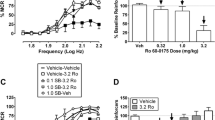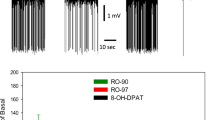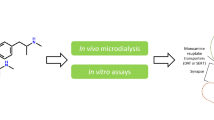Abstract
The effects of four serotonin (5-HT)-1A compounds (buspirone, gepirone, ipsapirone and zalospirone) were compared with 5-hydroxytryptophan (5-HTP) [a 5-HT precursor with antidepressant (AD) efficacy], and diazepam (a benzodiazepine anxiolytic), on a differential-reinforcement-of-low-rate 72-s (DRL 72-s) schedule. Past research has shown that AD and anxiolytic compounds each have distinct effects on the DRL 72-s interresponse time (IRT) distribution profile. In the present paper, the profile of the IRT distribution was quantitatively characterized by three metrics: burst ratio, peak location and peak area. 5-HTP shifted the IRT distribution peak toward longer IRT durations, increased reinforcement rate and decreased response rate. The profile of the IRT distribution was not disrupted by 5-HTP. Diazepam disrupted the IRT distribution and increased bursting. In general, the arylpiperazine, 5-HT1A compounds increased reinforcement rate, decreased response rate and disrupted the profile of the IRT distribution. The effects of the four arylpiperazine 5-HT1A compounds on the IRT distribution profile were different from the AD profile of 5-HTP and the benzodiazepine anxiolytic profile of diazepam. Disruption of the IRT distribution by buspirone, gepirone, ipsapirone and zalospirone may result from decreased 5-HT transmission mediated by the presynaptic, somatodendritic 5-HT1A receptor.
Similar content being viewed by others
References
Amsterdam JD, Berwish N, Potter L, Rickels K (1987) Open trial of gepirone in the treatment of major depressive disorder. Curr Ther Res 41:185–193
Aprison MH (1965) Research approaches to problems in mental illness: brain neurohumor-enzyme systems and behavior. Prog Brain Res 16:48–80
Bianchi G, Garattini S (1988) Blockade of alpha2-adrenoceptors by 1-(2-pyrimidinyl)-piperazine (PmP) in vivo and its relation to the activity of buspirone. Eur J Pharmacol 147:343–350
Bianchi G, Caccia S, Della Vedova F, Garattini S (1988) The alpha2-adrenoceptor antagonist activity of ipsapirone and gepirone is mediated by their common metabolite 1-(2-pyrimidinyl)-piperazine (PmP). Eur J Pharmacol 151:365–371
Bizot JC, Thiebot MH, Le Bihan C, Soubrie P, Simon P (1988) Effects of imipramine-like drugs and serotonin uptake blockers on delay of reward in rats. Possible implication in the behavioral mechanism of action of antidepressants. J Pharmacol Exp Ther 246:1144–1151
Byerley WF, Judd LL, Reimherr FW, Grosser BI (1987) 5-Hydroxytryptophan: a review of its antidepressant efficacy and adverse effects. J Clin Psychopharmacol 7:127–137
Caccia S, Conti I, Vigano G, Garattini S (1986) 1-(2-Pyrimidinyl)-piperazine as active metabolite of buspirone in man and rat. Pharmacology 33:46–51
Carter RB, Appel JB (1976) Blockade of the behavioral effects of 5-HTP by the decarboxylase inhibitor Ro 4-4602. Pharmacol Biochem Behav 4:407–409
Costa E, Guidotti A (1979) Molecular mechanisms in the receptor action of benzodiazepines. Annu Rev Pharmacol Toxicol 19:531–545
Gartside SE, Cowen PJ, Sharp T (1992) Effect of 5-hydroxy-l-tryptophan on the release of 5-HT in rat hypothalamus in vivo as measured by microdialysis. Neuropharmacology 31:9–14
Giral P, Soubrie P, Puech AJ (1987) Pharmacological evidence for the involvement of 1-(2-pyridinyl)-piperazine (1-PmP) in the interaction of buspirone or gepirone with noradrenergic systems. Eur J Pharmacol 134:113–116
Harto NE, Branconnier RJ, Spera KF, Dessain EC (1988) Clinical profile of gepirone, a nonbenzodiazepine anxiolytic. Psychopharmacol Bull 24:154–160
Haskins JT, Moyer JA, Andree TH, Muth EA, Abou-Gharbia M (1989) Preclinical profile of the pyrimidinylpiperazinyl imide compound WY-47,846: a potential anxiolytic. Drug Dev Res 18:29–45
Jolly DC, Richards JB, Seiden LS (1991) Depletion of brain serotonin with 5,7-dihydroxytryptamine is associated with a persistent behavioral deficit in rats performing on the differential reinforcement of low rate-72 second operant schedule of water reinforcement. Soc Neurosci Abstr 17:148
Kaneko M, Kumashiro H, Takahashi Y, Hoshino Y (1979) L-5-HTP treatment and serum 5-HT level after L-5-HTP loading on depressed patients. Neuropsychobiology 5:232–240
Keppel G (1973) Design and analysis: a researcher's handbook. Prentice-Hall, Englewood Cliffs, N.J.
Marek GJ, Seiden LS (1988) Effects of selective 5-hydroxtryptamine-2 and nonselective 5-hydroxytryptamine antagonists on the differential-reinforcement-of-low-rate 72-second schedule. J Pharmacol Exp Ther 244[2]: 650–658
Marek GJ, Li AA, Seiden LS (1989) Evidence for involvement of 5-hydroxytryptamine-1 receptors in antidepressant-like drug effects on differential reinforcement-of-low-rate 72-second behavior. J Pharmacol Exp Ther 250[1]: 60–70
Neter J, Wasserman W (1974) Applied linear statistical models. Richard D. Irwin, Inc, Homewood, Ill
O'Donnell JM, Seiden LS (1982) Effects of monoamine oxidase inhibitors on performance during differential reinforcement of low response rate. Psychopharmacology 78:214–218
O'Donnell JM, Seiden LS (1983) Differential-reinforcement-of-low-rate 72-second schedule: Selective effects of antidepressant drugs. J Pharmacol Exp Ther 224[1]: 80–88
Pei Q, Zetterstrom T, Fillenz M (1989) Both systemic and local administration of benzodiazepine agonists inhibit the in vivo release of 5-HT from ventral hippocampus. Neuropharmacology 28:1061–1066
Peroutka SJ (1985) Selective labeling of 5-HT1A and 5HT-1B binding sites in bovine brain. Brain Res 344:167–171
Rausch JL, Ruegg R, Moeller FG (1990) Gepirone as a 5-HT1A agonist in the treatment of major depression. Psychopharmacol Bull 26[2]: 169–171
Richards JB, Sabol KE, Seiden LS (1993a) DRL interresponse time distributions: quantification by peak deviation analysis. J Exp Anal Behav (in press)
Richards JB, Sabol KE, Seiden LS (1993b) Fluoxetine prevents the disruptive effects of fenfluramine on differential-reinforcement-of-low-rate 72-second schedule performance. J Pharmacol Exp Ther (in press)
Richards JB, Seiden LS (1991) A quantitative interresponse-time analysis of DRL performance differentiates similar effects of the antidepressant desipramine and the novel anxiolytic gepirone. J Exp Anal Behav 56:173–192
Sanger DJ, Blackman DE (1989) Operant behavior and the effects of centrally acting drugs. In: Boutlon AA, Baker GB, Greenshaw AJ (eds) Neuromethods 13 Psychopharmacology. Humana, Clifton, New Jersey, pp 299–348
Seiden LS, Dahms JL, Shaughnessy RA (1985) Behavioral screen for antidepressants: the effects of drugs and electroconvulsive shock on performance under a differential-reinforcement-of-low-rate schedule. Psychopharmacology 86:55–60
Sharp T, Bramwell SR, Grahame-Smith DG (1989) 5-HT1 agonists reduce 5-hydroxytryptamine release in rat hippocampus in vivo as determined by brain microdialysis. Br J Pharmacol 96:283–290
Skolnick P, Paul SM (1982) Benzodiazepine receptors in the central nervous system. Int Rev Neurobiol 23:103–140
Smith LM, Peroutka SJ (1986) Differential effects of 5-hydroxytryptamine1A selective drugs on the 5-HT behavioral syndrome. Pharmacol Biochem Behav 24:1513–1519
Snapper AG, Stephens KR, Cobez RI, Van Haaren F (1976) The SKED software system: OS8 and time share SKED. State Systems, Kalamazoo, Mich
Soubrie P (1989) 5-HT1A receptors: a bridge between anxiety and depression. In: Bevan P, Cools AR, Archer T (eds) Behavioral pharmacology of 5-HT. Lawrence Erlbaum, Hillsdale, New Jersey, pp 337–352
Soubrie P, Bizot JC (1990) Monoaminergic control of waiting capacity (impulsivity) in animals. In: Van Praag HM, Plutchik R, Apter A (eds) Violence and suicidality: perspectives in clinical and psychobiological research. Brunner/Mazel, New York, pp 257–272
Soubrie P, Blas C, Ferron A, Glowinski J (1983) Chlordiazepoxide reduces in vivo serotonin release in the basal ganglia of encephale isole but not anesthetized cats: evidence for a dorsal raphe site of action. J Pharmacol Exp Ther 226:526–532
Sprouse JS, Aghajanian GK (1988) Responses of hippocampal pyramidal cells to putative serotonin 5-HT1A and 5-HT1B agonists: a comparative study with dorsal raphe neurons. Neuropharmacology 27:707–715
Thiebot MH (1986) Are serotonergic neurons involved in the control of anxiety and in the anxiolytic activity of benzodiazepines? Pharmacol Biochem Behav 24:1471–1477
Thiebot M, Le Bihan C, Soubrie P, Simon P (1985) Benzodiazepines reduce the tolerance to reward delay in rats. Psychopharmacology 86:147–152
Thiebot M, Bizot J, Soubrie P (1991) Waiting capacity in animals: a behavioral component crossing nosologic boundaries of anxiety and depression? In: Soubrie P (ed) Anxiety, depression, and mania. Karger, Basel, pp 48–67
Traber J, Glaser T (1987) 5-HT1A receptor-related anxiolytics. TIPS 8:432–437
Van Praag HM (1981) Management of depression with serotonin precursors. Biol Psychiatry 16:291–310
Wise CD, Berger BD, Stein L (1972) Benzodiazepines: anxiety-reducing activity by reduction of serotonin turnover in the brain. Science 177:180–183
Yocca FD (1990) Neurochemistry and neurophysiology of buspirone and gepirone: interactions at presynaptic and postsynaptic 5-HT1A receptors. J Clin Psychopharmacol 10[suppl.]: 6S-12S
Author information
Authors and Affiliations
Rights and permissions
About this article
Cite this article
Richards, J.B., Sabol, K.E., Hand, T.H. et al. Buspirone, gepirone, ipsapirone, and zalospirone have distinct effects on the differential-reinforcement-of-low-rate 72-s schedule when compared with 5-HTP and diazepam. Psychopharmacology 114, 39–46 (1994). https://doi.org/10.1007/BF02245442
Received:
Revised:
Issue Date:
DOI: https://doi.org/10.1007/BF02245442




